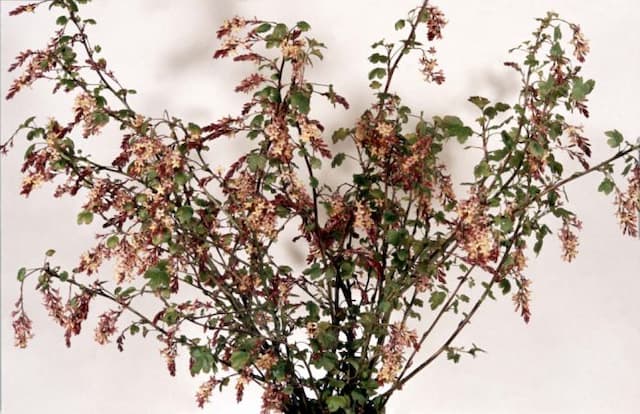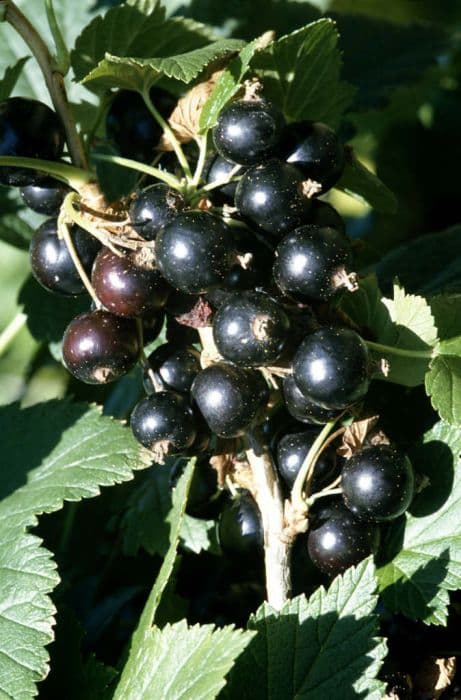Flowering Currant Ribes sanguineum 'Elkington's White'

ABOUT
The plant known as Elkington's White is a visually striking plant notable for its clusters of creamy white flowers. These flowers hang gracefully in long, drooping racemes that provide a soft and attractive display during its blooming period. The blooms give off a light, captivating fragrance and can be a magnet for local hummingbirds and other pollinators. The foliage of Elkington's White consists of green leaves which are rounded with multiple lobes, giving them a somewhat maple-like appearance. This foliage can exhibit a light to vibrant green color that serves as an elegant backdrop to the white flowers. The plant's overall growth habit is bushy, providing a dense and lush appearance, with branches that extend outward to create a full-looking shape. It is a plant that certainly stands out in garden settings due to its distinctive blooms and attractive foliage.
About this plant
 Names
NamesFamily
Grossulariaceae
Synonyms
Elkington's White Flowering Currant, White Winter Currant, White Flowering Currant
Common names
Ribes sanguineum 'Elkington's White'.
 Characteristics
CharacteristicsLife cycle
Perennials
Foliage type
Deciduous
Color of leaves
Green
Flower color
White
Height
6 feet (1.8 meters)
Spread
6 feet (1.8 meters)
Plant type
Shrub
Hardiness zones
6
Native area
North America
Benefits
 General Benefits
General Benefits- Attracts Pollinators: The flowers of the flowering currant provide nectar and pollen for bees and other pollinating insects.
- Aesthetic Appeal: 'Elkington's White' has attractive white flowers and a pleasing form, enhancing garden landscapes.
- Drought Tolerance: Once established, it can tolerate periods of low water, making it suitable for drought-prone areas.
- Wildlife Habitat: Provides food and shelter for birds and beneficial insects within the garden ecosystem.
- Seasonal Interest: Offers spring flowers and seasonal foliage changes, adding variation throughout the year.
- Low Maintenance: Flowering currant typically requires minimal care once established, making it an easy plant for gardeners of all levels.
- Cold Hardy: It's capable of surviving in cold climates, thus it can be grown in many regions without the need for special winter protection.
 Medical Properties
Medical PropertiesThis plant is not used for medical purposes.
 Air-purifying Qualities
Air-purifying QualitiesThis plant is not specifically known for air purifying qualities.
 Other Uses
Other Uses- Ribes sanguineum 'Elkington's White', or flowering currant, can be used in cut flower arrangements, providing an elegant and long-lasting white floral display.
- The shrub's dense branching habit makes it suitable as a natural privacy screen or hedge in a garden.
- Flowering currant's foliage can serve as a backdrop in photography or painting to create a contrasting effect with its light-colored leaves.
- The plant's berries, although not commonly consumed, can be used to make homemade dyes for fabrics or crafts.
- In a wildlife garden, the flowering currant's nectar-rich flowers can attract pollinators such as bees and butterflies, supporting local ecosystems.
- The shrub can be used as a parent in hybridization programs to develop new garden cultivars with desired traits like improved disease resistance or flower color.
- Used in permaculture design, flowering currant can provide a windbreak and microclimate for more delicate plants nearby.
- The strong, woody stems of mature plants can be used for small woodworking projects or as natural stakes in the garden.
- Due to its hearty nature, the plant can be utilized in erosion control projects on slopes or banks to prevent soil loss.
- The flowering currant can be planted in pots or containers for urban gardens or balconies where ground space is limited.
Interesting Facts
 Feng Shui
Feng ShuiThe Flowering Currant is not used in Feng Shui practice.
 Zodiac Sign Compitability
Zodiac Sign CompitabilityThe Flowering Currant is not used in astrology practice.
 Plant Symbolism
Plant Symbolism- Passion: The species name "sanguineum" is derived from the Latin word for "blood," referring to the red flowers of other varieties. Even in 'Elkington's White', where the flowers are white, the symbolism of passion and vitality carries over from the more common red-flowered varieties.
- Resilience: As Ribes sanguineum is a hardy shrub that can grow in various conditions, including partial shade, it symbolizes resilience and the ability to thrive in less-than-ideal situations.
- Ephemeral Beauty: The flowering currant, which this plant is commonly known as, has brief but beautiful blooms that symbolize the transient nature of beauty and life’s fleeting moments.
- Spring Renewal: Flowering currants are among the first plants to bloom in spring, thus they symbolize renewal, new beginnings, and the awakening of life after the winter dormancy.
- Protection: Historically, all currant bushes have been planted for their usefulness in that their fruits can be used to make preserves. In this sense, they symbolize provision and protection, ensuring sustenance through the winter months.
 Water
WaterWhite flowering currant requires regular watering, particularly during dry spells. During the growing season, ensure the soil around the plant is consistently moist but not waterlogged. Generally, watering about once a week with approximately 1 to 1.5 gallons of water per plant is sufficient. However, this can vary depending on climate conditions and soil type. For mature plants, reduce watering, allowing the soil to dry slightly between watering sessions. It's critical to avoid overhead watering to prevent leaf diseases, so water at the base of the plant.
 Light
LightWhite flowering currant thrives in full sun to partial shade. An ideal location would provide morning sunlight with some afternoon shade, particularly in hotter regions. Avoid deep shade, as it can reduce the plant's flowering potential and lead to leggy growth. To encourage a healthy and robust plant with abundant blooms, choose a spot that receives at least 4 to 6 hours of direct sunlight per day.
 Temperature
TemperatureWhite flowering currant performs best in temperate climates, with ideal growth occurring when the temperature is between 60 to 75 degrees Fahrenheit. They are hardy and can survive winter temperatures down to around 20 degrees Fahrenheit, but prolonged exposure below this can damage or kill the plant. In the summer, they can withstand temperatures up to 85 degrees Fahrenheit, but they prefer cooler conditions.
 Pruning
PruningPruning white flowering currant is necessary to maintain its shape, remove dead or damaged wood, and encourage healthy growth. The best time to prune is late winter to early spring before new growth begins. Prune out old wood that has already flowered, aiming to remove about a third of the oldest stems to the ground each year. This rejuvenates the plant and ensures a good display of flowers the following season.
 Cleaning
CleaningAs needed
 Soil
SoilFlowering Currant prefers well-draining soil with high organic matter; a soil mix with loam, peat moss, and perlite works well. The ideal soil pH is slightly acidic to neutral, ranging from 6.0 to 7.0.
 Repotting
RepottingFlowering Currant does not need frequent repotting and can thrive in the same pot for several years. Repot every 3-5 years or when the plant has outgrown its current container.
 Humidity & Misting
Humidity & MistingFlowering Currant tolerates a wide range of humidity levels but thrives best in moderate humidity; avoid extremely dry air by providing a natural outdoor environment or occasional misting indoors.
 Suitable locations
Suitable locationsIndoor
Place in bright, indirect light and maintain cool temperatures.
Outdoor
Choose a sunny to part shade spot, ensure soil drainage.
Hardiness zone
6-9 USDA.
 Life cycle
Life cycleThe 'Elkington's White' flowering currant begins its life cycle when its seeds germinate in late spring or early summer, after which young seedlings establish themselves with a set of true leaves. The plant enters a vegetative stage, where it focuses on leaf and stem growth, gradually maturing to form a deciduous shrub. Over several years, it reaches flowering maturity, typically blooming in early to mid-spring with clusters of white, pendulous flowers that attract pollinators. Following pollination, the flowers develop into small, non-edible berries by late summer, which provide food for birds and other wildlife, thereby aiding in seed dispersal. As fall approaches, 'Elkington's White' prepares for dormancy, shedding its leaves and entering a period of rest during the winter months. Lastly, the plant emerges from dormancy in spring to start a new cycle, continuing to grow larger and more prolific with each passing year until it ultimately dies after its lifespan is complete.
 Propogation
PropogationPropogation time
Late winter to early spring
The Flowering Currant 'Elkington's White' is commonly propagated through softwood cuttings taken in late spring or early summer. To propagate by this method, a gardener would select healthy, non-flowering shoots and cut segments approximately 4 to 6 inches (10 to 15 centimeters) long. Leaves on the lower half of the cutting should be removed, and the cut end dipped into a rooting hormone to encourage root development. The prepared cuttings are then inserted into a well-draining rooting medium, such as a mix of perlite and peat, ensuring that at least two nodes are buried where leaves were removed. The environment should be kept humid by covering the cuttings with a plastic bag or propagator lid and placed in indirect light. Rooting typically takes several weeks, after which the cuttings can be potted up individually and grown on until they are ready to be planted out in the garden.








